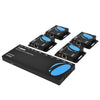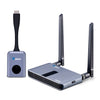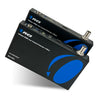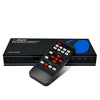
Have you ever tried setting up a display system in your home or your business? For example, you want to create an advertisement system in your local shop. You set up your TVs on your store front, all ready to showcase the great products or services you offer. However, you realize that you cannot leave your laptop right next to your display because it breaks the setup. You place your laptop, or media device, in a nearby room, you run your HDMI cables, but your display isn’t as good as you wanted. That’s because most HDMI splitters can only reach up to 30 feet (in cable length) before their quality deteriorates. Here’s where an HDMI Extender over CAT6–also known as HDMI over Ethernet or HDMI over CAT6–or simply, HDMI Extender, comes in handy.
In this comprehensive guide, we'll delve into what HDMI extenders are, how they work, and their wide-ranging applications, including advanced uses. We'll also explore why you might need an extender that can span up to 130 feet and the impressive benefits they provide.
What is an HDMI Extender?
An HDMI extender is a device that allows you to transmit high-definition audio and video signals over long distances, typically beyond the limitations of standard HDMI cables, which are usually limited to around 30 feet. HDMI extenders are designed to maintain the quality and integrity of these signals, making them suitable for a wide range of applications.
The key components of an HDMI Extender are its transmitter and the receiver.


To simplify the process even further, think of the transmitter as the starting line of a relay race, where your signal begins its journey, and the receiver as the finish line, where it's delivered in all its high-definition glory.
What Are HDMI Extenders Used For?
Although HDMI Extenders may sound a bit complex, they have an incredible range of real-world applications. These devices are the unsung heroes behind various setups, ensuring seamless connectivity between your media source devices and distant displays.
You might have also been wondering why you’d ever need an HDMI Extender over CAT6 capable of reaching up to 130 feet, or even more. The answer is simple: it's all about preserving the quality and integrity of audio and video signals, even when your media source and display are significantly far apart. HDMI Extenders with this kind of range open up a world of possibilities, making them indispensable for a wide range of professional and recreational applications such as:
Also, as mentioned earlier, CAT6 HDMI Extenders doesn’t simply extend your signal to larger distances, it does so with the following benefits:
Benefits of Using HDMI Extenders
Before we end this discussion, it’s important to know that when it comes to HDMI extenders, one size does not fit all. The right extender for your setup depends on various factors, including the distance you need to cover and specific features you may require. Here are some examples of various HDMI extenders based on different distances and features, ensuring you can choose the perfect fit for your unique needs.
For shorter distances, typically ranging from 50-150 feet, standard HDMI extenders do the job efficiently. These are suitable for connecting your source device to a display within the same room or between 2 rooms. No additional features are necessary, but OREI does provide basic features like IR Control and Power Over Ethernet with their devices.
When you need to bridge a moderate distance, spanning up to 100 feet or more with multiple displays, HDMI Extender Splitters are ideal. These are essentially HDMI Splitters that work over Ethernet. Extender Splitters are available in various options such as 1x2, 1x4 and 1x8. They usually include 1 Transmitter and 2 or more Receivers. They offer excellent signal quality, easy setup, and also include features like IR control to manage your devices remotely.
For extensive distances, up to 200 feet or more with a requirement of multiple features, High Range HDMI extenders become essential. These advanced extenders ensure signal integrity over long distances and they include a multitude of features like KVM, ARC/eARC, etc., making them versatile for various applications. A great example is OREI’s UHD-EXB350EAU-K, which is sort of an all-in-one extender with great features.
For longer distances and multiple inputs & outputs, a Matrix Extender does the job. A Matrix Extender essentially combines the functionality of a Matrix with the power of an Extender, giving you the best of both worlds. Some Matrix Extenders allow you to connect up to 8 sources and 8 displays, allowing you to switch between them with ease.
In summary, HDMI Extenders provide a simple solution to the challenge of extending your HDMI signal to long distances. OREI HDMI Extenders, with their advanced capabilities, cater to various distances and feature requirements. OREI’s HDMI extenders can help you unlock the magic of short or long-distance signal transmission, making your viewing, presentation, and transmission experiences seamless and efficient.
Start your HDMI extender journey today by taking a look at a wide range of available HDMI extenders at OREI’s official shop. Click here to take a look!
For more articles about different types of HDMI devices and setups, feel free to take a look at our blog.





















